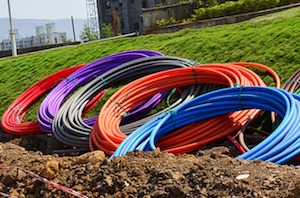
Fast, affordable Internet access for all.

The federal government has awarded a $2.74 million grant to Hayward, California, to help fund the design and installation of conduit and fiber-optic network in the city’s industrial zone.
The grant, from the U.S. Department of Commerce’s Economic Development Administration, will enable Hayward (pop. 150,000) to install at least 11 miles of new conduit and fiber optic cable, the city said in a recent news release. Construction will begin in September 2017, and should be finished by the fall of 2019.
Paul Nguyen, city economic development specialist, told us, “The $2.7 million grant award is 50 percent of the total estimated project cost, roughly $5.4 million.” The city’s matching share of the project includes a $2.1 million in-kind contribution of the city's publicly-owned right-of-way property, $480,000 in general funds, and an additional $156,000 that has already been committed to the construction and installation of fiber-optic conduit in the Whitesell Street segment of the fiber loop.
Leveraging Existing Infrastructure
In its news release, Hayward officials said:
“The fiber optic network will leverage existing city-owned underground conduit and fiber optic cables used primarily for traffic communications and include new construction to complete a loop in the Industrial Technology and Innovation Corridor. This crescent-shaped corridor, located along Hayward’s western and southwestern city limit, is home to a wide range of businesses including manufacturers of food, pharmaceuticals, auto parts and electronics. The area is also becoming home to an increasing number of biotechnology and medical device makers.”
Nguyen noted:
“Today, access to broadband Internet service is as vital to industry as electricity was a hundred years ago. This federal funding will help expand Hayward’s broadband infrastructure and enhance our community’s ability to attract new advanced industries. It will also provide our existing businesses with the tools they need be competitive in today’s high-speed, data-driven global economy.”
Expectations, Planning

One or more Internet Service Providers (ISPs) are expected to lease fiber optic cable strands and/or physical space from Hayward in the new conduit, the city said. Hayward is eyeing San Leandro Dark Fiber to serve as the ISP for the city network. That same company is the ISP serving San Leandro’s municipal network, Lit San Leandro.
Hayward’s federal EDA grant comes as the city is starting to draft a Fiber Optic Master Plan. The draft plan, scheduled for completion by the end of 2016, is expected to offer recommendations on the fiber network’s specifications, route, management, and phased implementation, city officials said.
Meanwhile, Hayward hopes the project will lead to lower connectivity costs for businesses already paying for faster broadband speed. Local officials are particularly concerned about connectivity for small- to medium-sized businesses in the city’s older industrial parks, where infrastructure needs to be updated, the Eastern Bay Times reported. Hayward, which is part of the San Francisco metropolitan area, has a mix of businesses from heavy manufacturers to artisan food makers, Nguyen told the Times.
According to a November 3rd staff report:
This high-speed fiber optic access is expected to improve local business operations and allow businesses to capture economic opportunities created by data and Internet driven industries in the Bay Area. In addition, this EDA investment is expected to create 148 jobs, retain 26 jobs, and lead to more employment opportunities for the region’s workforce.
Other Cities Pursuing Conduit Networks
Hayward joins several other U.S. communities pursuing high-speed Internet service with conduit infrastructure. In episode #228 of the Community Broadband Bits podcast, we discussed how Lincoln, Nebraska (pop. 280,000) is benefitting from its innovative conduit program to improve Internet access. We also visited with officials from Lincoln for episode #182.
For more excellent models of conduit policy, check out Mount Vernon, Washington; Brentwood, California; Centennial, Colorado; and Saint Louis Park, Minnesota.
